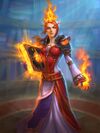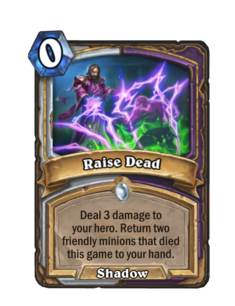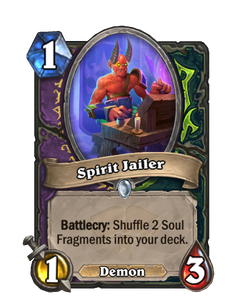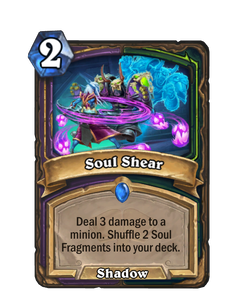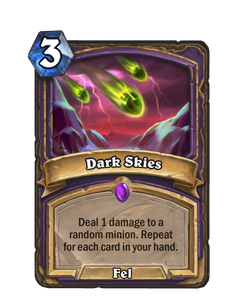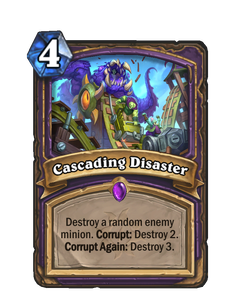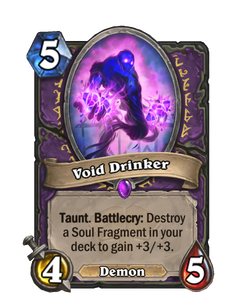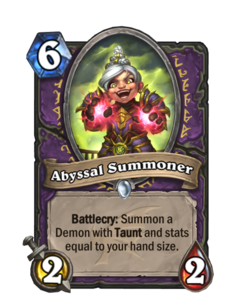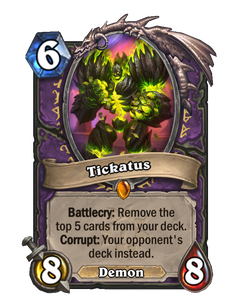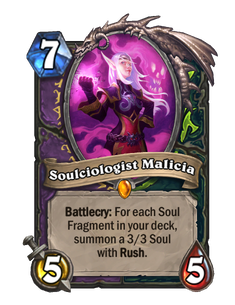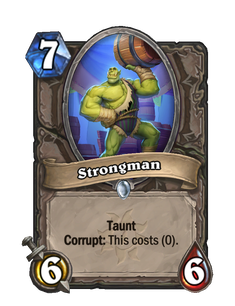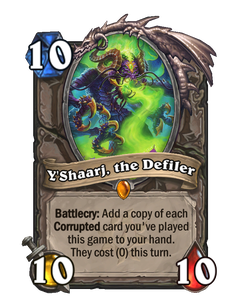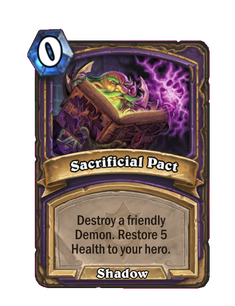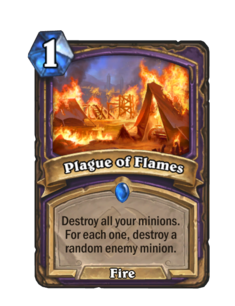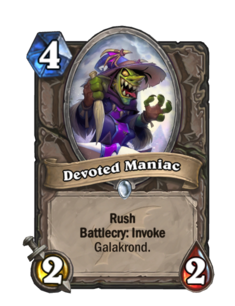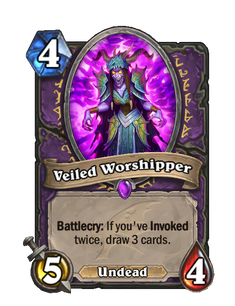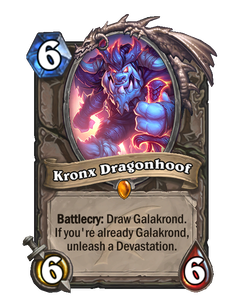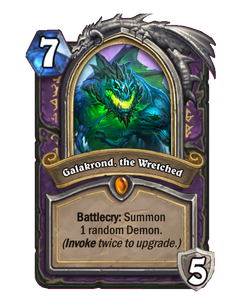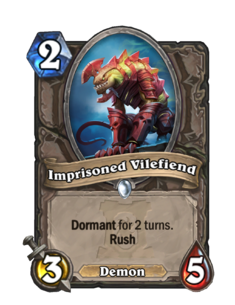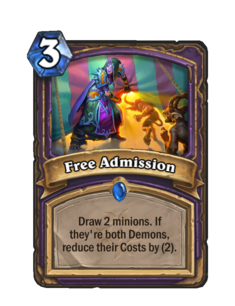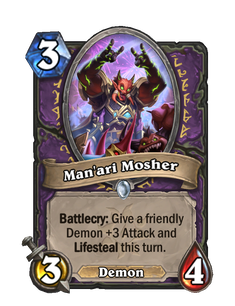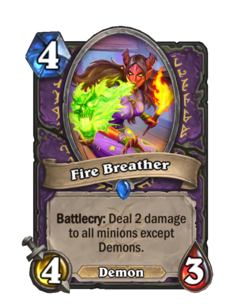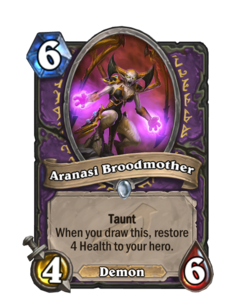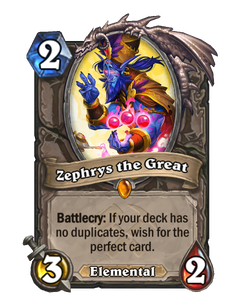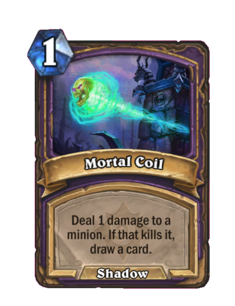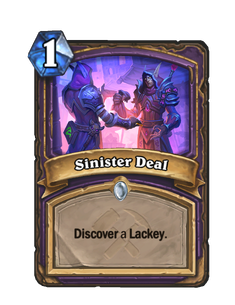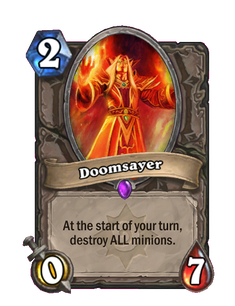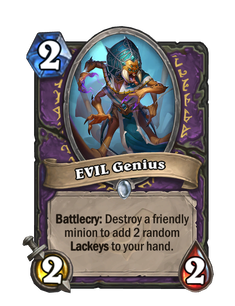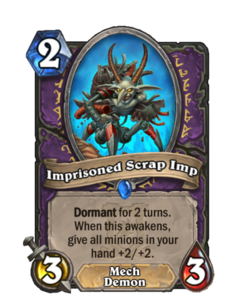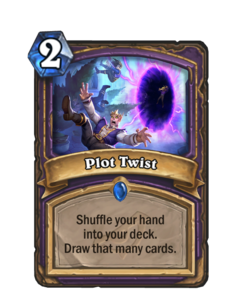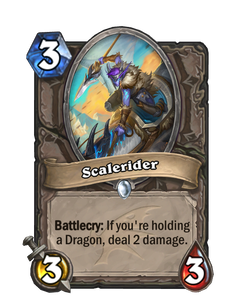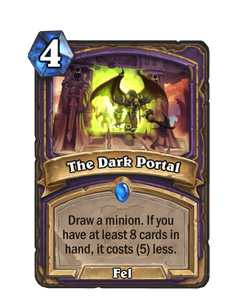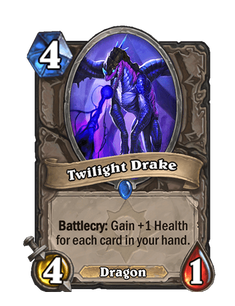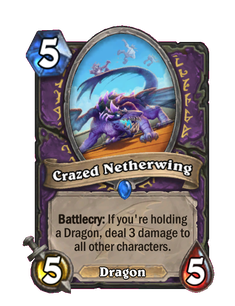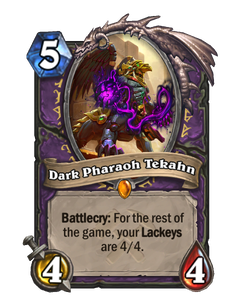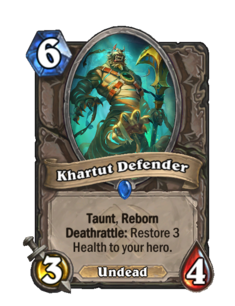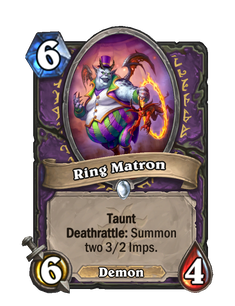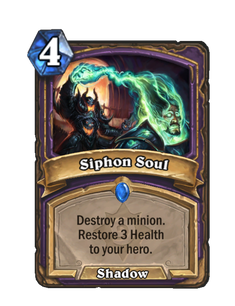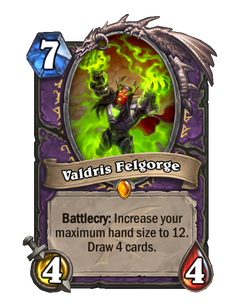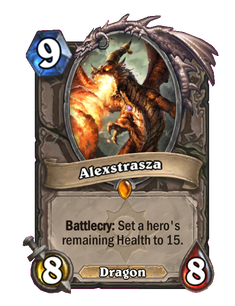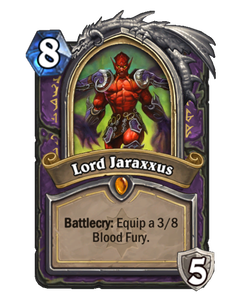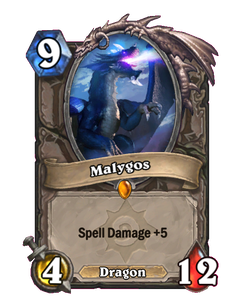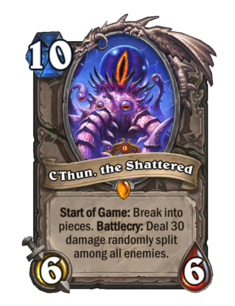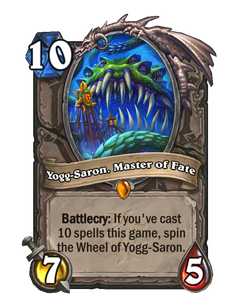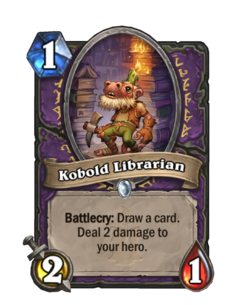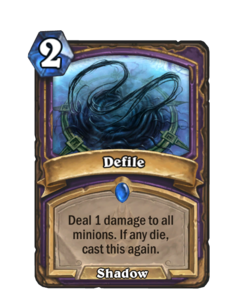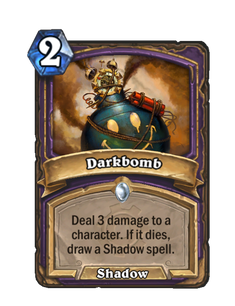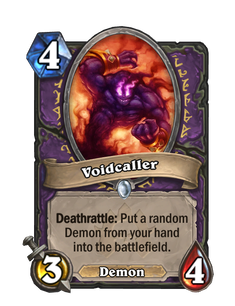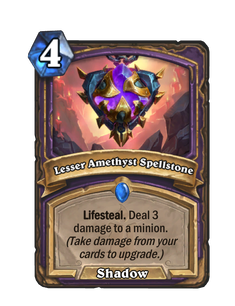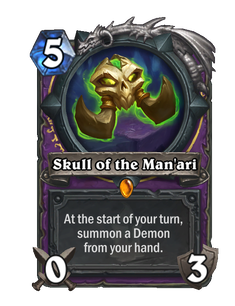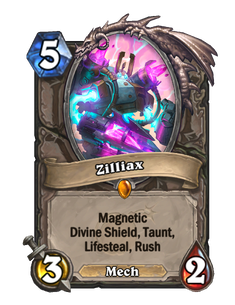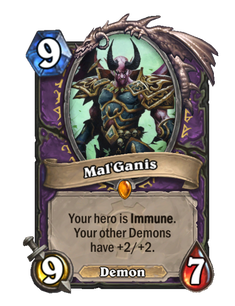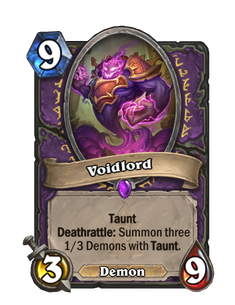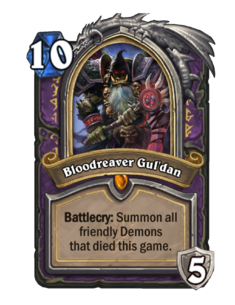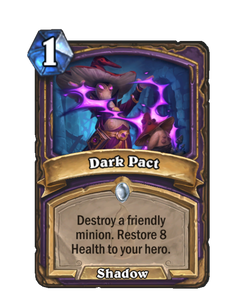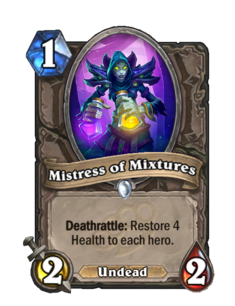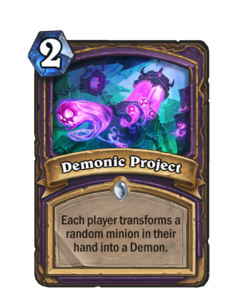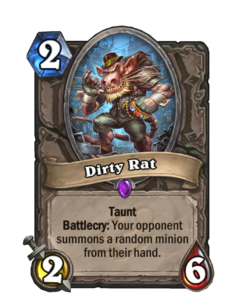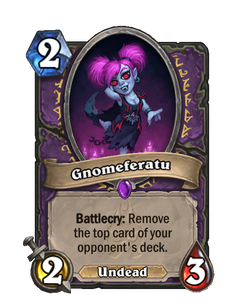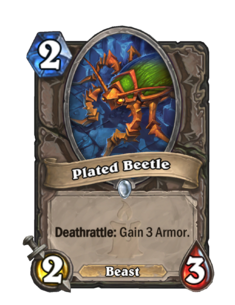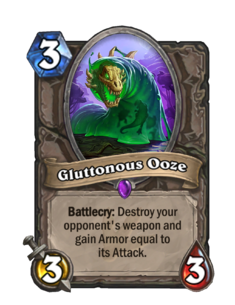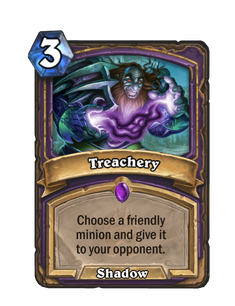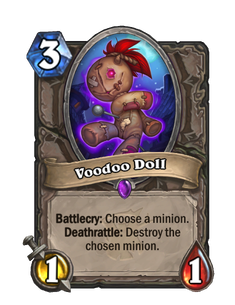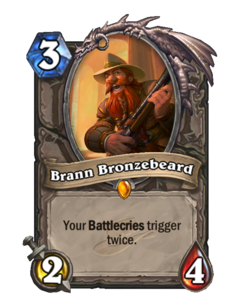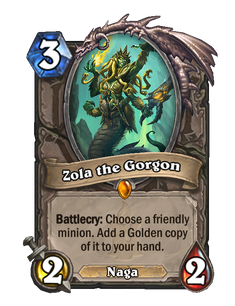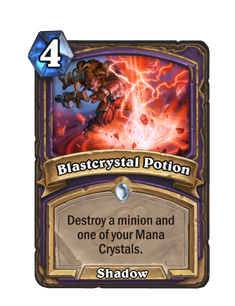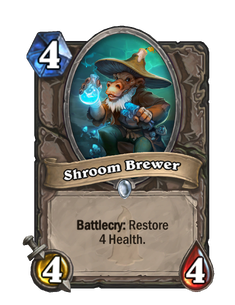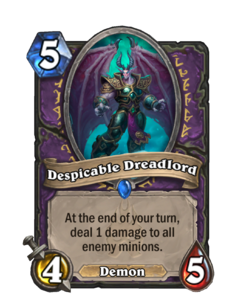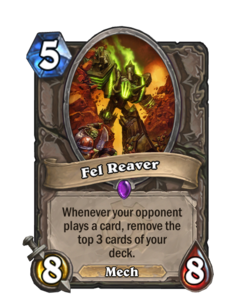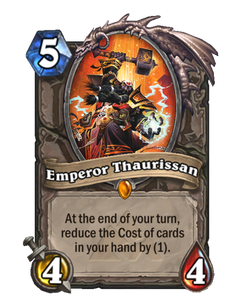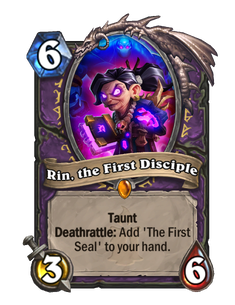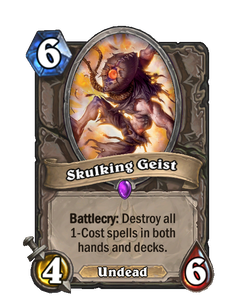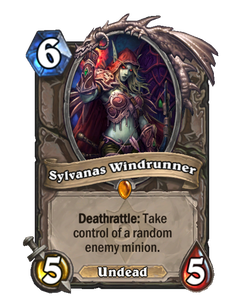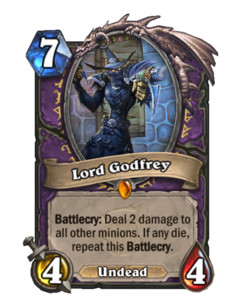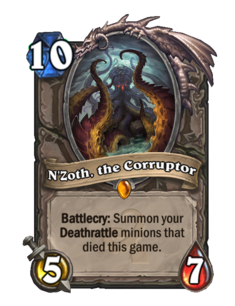Hearthstone Wiki:Archived/Control Warlock
They may also contain information that changes at such a rapid pace that maintaining them is no longer practical.
Control Warlock, not to be confused with Handlock, is a Warlock control deck aiming to outlast opponents using their powerful removal tools while gradually overvaluing their opponent to win the game. Compared to other slow Warlock decks, it doesn't utilize combo burst damage like Cubelock or make heavy use of hand-based synergy cards like ![]() Mountain Giant to create an overwhelming mid-game, although they do share many core cards.
Mountain Giant to create an overwhelming mid-game, although they do share many core cards.
Control Warlock first saw mainstream play in Kobolds and Catacombs, using ![]() Bloodreaver Gul'dan from the previous expansion with powerful Demon card additions like
Bloodreaver Gul'dan from the previous expansion with powerful Demon card additions like ![]() Voidlord and
Voidlord and ![]() Skull of the Man'ari, as well as
Skull of the Man'ari, as well as ![]() Rin, the First Disciple to beat the opponent in the fatigue game against other control decks. Once the set rotated out of Standard, Control Warlock did not see play until Descent of Dragons, which brought the Warlock better late-game cards and
Rin, the First Disciple to beat the opponent in the fatigue game against other control decks. Once the set rotated out of Standard, Control Warlock did not see play until Descent of Dragons, which brought the Warlock better late-game cards and ![]() Galakrond, the Wretched to stabilize the early game.
Galakrond, the Wretched to stabilize the early game.
Deck type[edit source]
- Year of the Mammoth
Control Warlock's most powerful tools were ![]() Bloodreaver Gul'dan and
Bloodreaver Gul'dan and ![]() Azari, the Devourer. With them, it was very hard outlast a Control Warlock as many cards the deck utilizes scales in value as the game goes on.
Azari, the Devourer. With them, it was very hard outlast a Control Warlock as many cards the deck utilizes scales in value as the game goes on.
Control Warlock does not have many tools to contest the board in the early game, but ![]() Kobold Librarian,
Kobold Librarian, ![]() Gnomeferatu, and
Gnomeferatu, and ![]() Stonehill Defender are fair minions which also serve useful purposes in a control matchup, with Gnomeferatu serving as a possible combo-denying win condition, and the other two serving as card draw, which is essential in all matchups.
Stonehill Defender are fair minions which also serve useful purposes in a control matchup, with Gnomeferatu serving as a possible combo-denying win condition, and the other two serving as card draw, which is essential in all matchups. ![]() Defile,
Defile, ![]() Doomsayer, and
Doomsayer, and ![]() Hellfire are also very reliable and efficient ways to hold off Aggro decks.
Hellfire are also very reliable and efficient ways to hold off Aggro decks.
![]() Skull of the Man'ari is powerful when played on curve, being able to potentially put a
Skull of the Man'ari is powerful when played on curve, being able to potentially put a ![]() Voidlord onto the battle field by turn 6, usually bringing a victory against most aggro decks on its own.
Voidlord onto the battle field by turn 6, usually bringing a victory against most aggro decks on its own. ![]() Lesser Amethyst Spellstone and
Lesser Amethyst Spellstone and ![]() Siphon Soul are often used in the mid-game to stop larger threats such as
Siphon Soul are often used in the mid-game to stop larger threats such as ![]() Savannah Highmane and
Savannah Highmane and ![]() The Lich King
The Lich King
Bloodreaver Gul'dan's battlecry is very powerful due to the inclusion of only more powerful demons, when playing against decks with many Silence, Transform, or Return to hand effects, destroying a friendly ![]() Voidlord can be advantageous, as certain death to the voidlord would mean that Gul'dan would certainly resummon the voidlord.
Voidlord can be advantageous, as certain death to the voidlord would mean that Gul'dan would certainly resummon the voidlord.
In the late game, ![]() Bloodreaver Gul'dan's hero power outdamages almost every other hero power, often winning games on its own. More commonly,
Bloodreaver Gul'dan's hero power outdamages almost every other hero power, often winning games on its own. More commonly, ![]() Rin, the First Disciple will destroy the enemy deck before fatigue. Rin is a very large threat to control decks, but due to its vulnerability to Silence and Transform effects, she is a common target for
Rin, the First Disciple will destroy the enemy deck before fatigue. Rin is a very large threat to control decks, but due to its vulnerability to Silence and Transform effects, she is a common target for ![]() Dark Pact, in cases where dark pact is not included in the deck, killing her as soon as possible is still beneficial, this could mean taking less advantageous trades.
Dark Pact, in cases where dark pact is not included in the deck, killing her as soon as possible is still beneficial, this could mean taking less advantageous trades.
If Combo Decks are prominent in the meta, then Control Warlock can tech against it in the way of including cards that allow Gnomeferatu to be played multiple times, such as ![]() Zola the Gorgon,
Zola the Gorgon, ![]() Baleful Banker, and
Baleful Banker, and ![]() Glinda Crowskin, this drastically increases the chances of Gnomeratu removing a combo piece from the deck and accelerates the opponent to fatigue.
Glinda Crowskin, this drastically increases the chances of Gnomeratu removing a combo piece from the deck and accelerates the opponent to fatigue.
This version of Control Warlock continues to see play in Wild. Reno Warlock is sometimes synonymous with Control Warlock due to the strength of ![]() Kazakus,
Kazakus, ![]() Reno Jackson,
Reno Jackson, ![]() Zephrys the Great, and
Zephrys the Great, and ![]() Dragonqueen Alexstrasza, Reno Warlock tries to accomplish the same goal of a standard Control Warlock, but focuses more on burst damage through
Dragonqueen Alexstrasza, Reno Warlock tries to accomplish the same goal of a standard Control Warlock, but focuses more on burst damage through ![]() Power Overwhelming and
Power Overwhelming and ![]() Leeroy Jenkins, where as Control Warlock focuses more on board control, tempo, and outlasting the opponent.
Leeroy Jenkins, where as Control Warlock focuses more on board control, tempo, and outlasting the opponent.
- Year of the Dragon
Control Warlock was nonexistent in the Standard meta following the removal of many control cards that enabled the deck, with the lack of good additions to make up for it. With the release of Descent of Dragons, Control Warlock began to see play again. Unlike Handlock, Control Warlock uses ![]() Galakrond, the Wretched and Invoke cards to give themselves a significant early and mid-game presence,
Galakrond, the Wretched and Invoke cards to give themselves a significant early and mid-game presence, ![]() Veiled Worshipper to reload their hand,
Veiled Worshipper to reload their hand, ![]() Kronx Dragonhoof to stabilize, and Galakrond himself to switch their Hero Power when their deck is running low. Galakrond's Invoke makes it easy to fill the board for
Kronx Dragonhoof to stabilize, and Galakrond himself to switch their Hero Power when their deck is running low. Galakrond's Invoke makes it easy to fill the board for ![]() Plague of Flames to wipe out the entire board. Galakrond Warlock (sometimes called Control Galakrond Warlock to distinguish it from the zoo variant) became the main control Warlock deck of the meta.
Plague of Flames to wipe out the entire board. Galakrond Warlock (sometimes called Control Galakrond Warlock to distinguish it from the zoo variant) became the main control Warlock deck of the meta.
The deck often runs a Dragon synergy package, with ![]() Nether Breath and
Nether Breath and ![]() Crazed Netherwing serving as powerful stabilizing tools. The deck often uses
Crazed Netherwing serving as powerful stabilizing tools. The deck often uses ![]() Zephrys the Great and
Zephrys the Great and ![]() Dragonqueen Alexstrasza, even in non-Highlander versions of the deck as a way to close out very long games. Sometimes the deck runs
Dragonqueen Alexstrasza, even in non-Highlander versions of the deck as a way to close out very long games. Sometimes the deck runs ![]() Malygos with Nether Breath and
Malygos with Nether Breath and ![]() Soulfire to deal direct burst damage, using
Soulfire to deal direct burst damage, using ![]() Frizz Kindleroost's mana discount to enable the combo.
Frizz Kindleroost's mana discount to enable the combo.
Some version of the deck also use a Lackey synergy deck, using ![]() Dark Pharaoh Tekahn with
Dark Pharaoh Tekahn with ![]() Glinda Crowskin or
Glinda Crowskin or ![]() Grand Lackey Erkh to flood the board with 4/4 minions while gaining board control or value from them.
Grand Lackey Erkh to flood the board with 4/4 minions while gaining board control or value from them.
- Year of the Phoenix
Control Warlock received a major boost in popularity in this year, thanks to the synergy between ![]() Mo'arg Artificer and
Mo'arg Artificer and ![]() Nether Breath, giving them a huge way to recover from early aggression. The deck was also a notable counter to early Aggro Demon Hunter builds, thanks to
Nether Breath, giving them a huge way to recover from early aggression. The deck was also a notable counter to early Aggro Demon Hunter builds, thanks to ![]() Sacrificial Pact originally destroying targets like
Sacrificial Pact originally destroying targets like ![]() Priestess of Fury for free, or simply being used to heal while still clearing minions like
Priestess of Fury for free, or simply being used to heal while still clearing minions like ![]() Battlefiend and
Battlefiend and ![]() Frenzied Felwing. This was impactful enough that Sac Pact was nerfed to only target friendly.
Frenzied Felwing. This was impactful enough that Sac Pact was nerfed to only target friendly.
Warlock lost some steam in the aggressive Scholomance Academy meta, but recovered in Madness at the Darkmoon Faire thanks to powerful disruption tools. With ![]() Tickatus, Warlock gained a niche as an anti-control deck that could bring the opponent to fatigue while burning away ten or more threats. Although not a powerhouse deck thanks to their poor matchups with Soul Demon Hunter and Evolve Shaman, Warlocks could efficiently handle other control decks. With the strong swing turn of
Tickatus, Warlock gained a niche as an anti-control deck that could bring the opponent to fatigue while burning away ten or more threats. Although not a powerhouse deck thanks to their poor matchups with Soul Demon Hunter and Evolve Shaman, Warlocks could efficiently handle other control decks. With the strong swing turn of ![]() Y'Shaarj, the Defiler, the deck was perfect for wearing opponents down.
Y'Shaarj, the Defiler, the deck was perfect for wearing opponents down.
At this time, a Demon variant of the deck arose, which attempted to highroll ![]() Tickatus with
Tickatus with ![]() Free Admission, reducing his cost, as well as abusing the burst healing of
Free Admission, reducing his cost, as well as abusing the burst healing of ![]() Man'ari Mosher. Other decks tried to double or triple up on Tickatus with
Man'ari Mosher. Other decks tried to double or triple up on Tickatus with ![]() Felosophy, putting heavy pressure on with multiple 8/8s that quickly removed the opponent's deck.
Felosophy, putting heavy pressure on with multiple 8/8s that quickly removed the opponent's deck.
Common Cards[edit source]
The following cards are usually in the deck.
Core Standard cards[edit source]
The following cards are played in most or all Standard versions of the deck:
Galakrond Build[edit source]
The following cards are commonly played in the Galakrond version.
Demon Build[edit source]
The following cards are commonly played in the Demon variation.
Highlander Build[edit source]
- Main article: Renolock
The following cards are commonly played in the standard highlander version:
Optional Standard cards[edit source]
The following cards are played more than occasionally, but not always:
Core Wild cards[edit source]
The following cards are played in most or all Wild versions of the deck:

